Publications
-
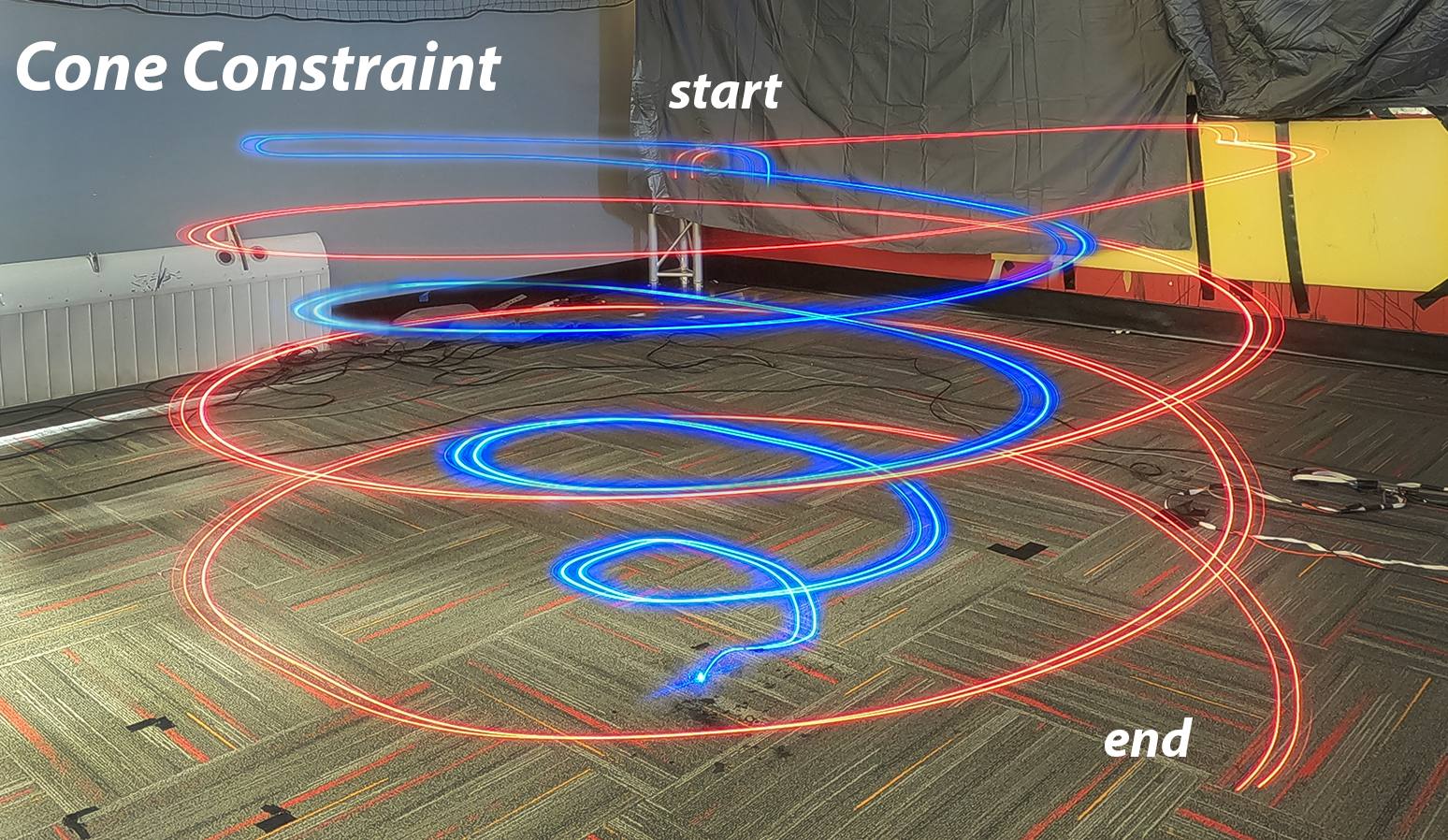 Code Generation and Conic Constraints for Model-Predictive Control on Microcontrollers with Conic-TinyMPCUnder Review , 2025Model-predictive control (MPC) is a powerful framework for controlling dynamic systems under constraints, but it remains challenging to deploy on resource-constrained platforms, especially for problems involving conic constraints. To address this, we extend recent work developing fast, structure-exploiting, cached ADMM solvers for embedded applications, to provide support for second-order cones, as well as C++ code generation from Python, MATLAB, and Julia for easy deployment. Microcontroller benchmarks show that our solver provides up to a two-order-of-magnitude speedup, ranging from 10.6x to 142.7x, over state-of-the-art embedded solvers on QP and SOCP problems, and enables us to fit order-of-magnitude larger problems in memory. We validate our solver’s deployed performance through simulation and hardware experiments, including conically-constrained trajectory tracking on a 27g Crazyflie quadrotor.
Code Generation and Conic Constraints for Model-Predictive Control on Microcontrollers with Conic-TinyMPCUnder Review , 2025Model-predictive control (MPC) is a powerful framework for controlling dynamic systems under constraints, but it remains challenging to deploy on resource-constrained platforms, especially for problems involving conic constraints. To address this, we extend recent work developing fast, structure-exploiting, cached ADMM solvers for embedded applications, to provide support for second-order cones, as well as C++ code generation from Python, MATLAB, and Julia for easy deployment. Microcontroller benchmarks show that our solver provides up to a two-order-of-magnitude speedup, ranging from 10.6x to 142.7x, over state-of-the-art embedded solvers on QP and SOCP problems, and enables us to fit order-of-magnitude larger problems in memory. We validate our solver’s deployed performance through simulation and hardware experiments, including conically-constrained trajectory tracking on a 27g Crazyflie quadrotor. -
 TAG-K: Tail-Averaged Greedy Kaczmarz for Computationally Efficient and Performant Online Inertial Parameter EstimationUnder Review , 2025Accurate online inertial parameter estimation is essential for adaptive robotic control, enabling real-time adjustment to payload changes, environmental interactions, and system wear. Traditional methods such as Recursive Least Squares (RLS) and the Kalman Filter (KF) often struggle to track abrupt parameter shifts or incur high computational costs, limiting their effectiveness in dynamic environments and for computationally constrained robotic systems. As such, we introduce TAG-K, a lightweight extension of the Kaczmarz method that combines greedy randomized row selection for rapid convergence with tail averaging for robustness under noise and inconsistency. This design enables fast, stable parameter adaptation while retaining the low per-iteration complexity inherent to the Kaczmarz framework. We evaluate TAG-K in synthetic benchmarks and quadrotor tracking tasks against RLS, KF, and other Kaczmarz variants. TAG-K achieves 1.5x-1.9x faster solve times on laptop-class CPUs and 4.8x-20.7x faster solve times on embedded microcontrollers. More importantly, these speedups are paired with improved resilience to measurement noise and a 25% reduction in estimation error, leading to nearly 2x better end-to-end tracking performance.
TAG-K: Tail-Averaged Greedy Kaczmarz for Computationally Efficient and Performant Online Inertial Parameter EstimationUnder Review , 2025Accurate online inertial parameter estimation is essential for adaptive robotic control, enabling real-time adjustment to payload changes, environmental interactions, and system wear. Traditional methods such as Recursive Least Squares (RLS) and the Kalman Filter (KF) often struggle to track abrupt parameter shifts or incur high computational costs, limiting their effectiveness in dynamic environments and for computationally constrained robotic systems. As such, we introduce TAG-K, a lightweight extension of the Kaczmarz method that combines greedy randomized row selection for rapid convergence with tail averaging for robustness under noise and inconsistency. This design enables fast, stable parameter adaptation while retaining the low per-iteration complexity inherent to the Kaczmarz framework. We evaluate TAG-K in synthetic benchmarks and quadrotor tracking tasks against RLS, KF, and other Kaczmarz variants. TAG-K achieves 1.5x-1.9x faster solve times on laptop-class CPUs and 4.8x-20.7x faster solve times on embedded microcontrollers. More importantly, these speedups are paired with improved resilience to measurement noise and a 25% reduction in estimation error, leading to nearly 2x better end-to-end tracking performance.
-
 Robust and Efficient Embedded Convex Optimization through First-Order Adaptive CachingIn IEEE/RSJ International Conference on Intelligent Robots and Systems (IROS) , 2025Recent advances in Model Predictive Control (MPC) leveraging a combination of first-order methods, such as the Alternating Direction Method of Multipliers (ADMM), and offline precomputation and caching of select operations, have excitingly enabled real-time MPC on microcontrollers. Unfortunately, these approaches require the use of fixed hyperparameters, limiting their adaptability and overall performance. In this work, we introduce First-Order Adaptive Caching, which precomputes not only select matrix operations but also their sensitivities to hyperparameter variations, enabling online hyperparameter updates without full recomputation of the cache. We demonstrate the effectiveness of our approach on a number of dynamic quadrotor tasks, achieving up to a 63.4% reduction in ADMM iterations over the use of optimized fixed hyperparameters and approaching 70% of the performance of a full cache recomputation, while reducing the computational cost from O(n^3) to O(n^2) complexity. This performance enables us to perform figure-eight trajectories on a 27g tiny quadrotor under wind disturbances. We release our implementation open-source for the benefit of the wider robotics community.
Robust and Efficient Embedded Convex Optimization through First-Order Adaptive CachingIn IEEE/RSJ International Conference on Intelligent Robots and Systems (IROS) , 2025Recent advances in Model Predictive Control (MPC) leveraging a combination of first-order methods, such as the Alternating Direction Method of Multipliers (ADMM), and offline precomputation and caching of select operations, have excitingly enabled real-time MPC on microcontrollers. Unfortunately, these approaches require the use of fixed hyperparameters, limiting their adaptability and overall performance. In this work, we introduce First-Order Adaptive Caching, which precomputes not only select matrix operations but also their sensitivities to hyperparameter variations, enabling online hyperparameter updates without full recomputation of the cache. We demonstrate the effectiveness of our approach on a number of dynamic quadrotor tasks, achieving up to a 63.4% reduction in ADMM iterations over the use of optimized fixed hyperparameters and approaching 70% of the performance of a full cache recomputation, while reducing the computational cost from O(n^3) to O(n^2) complexity. This performance enables us to perform figure-eight trajectories on a 27g tiny quadrotor under wind disturbances. We release our implementation open-source for the benefit of the wider robotics community. -
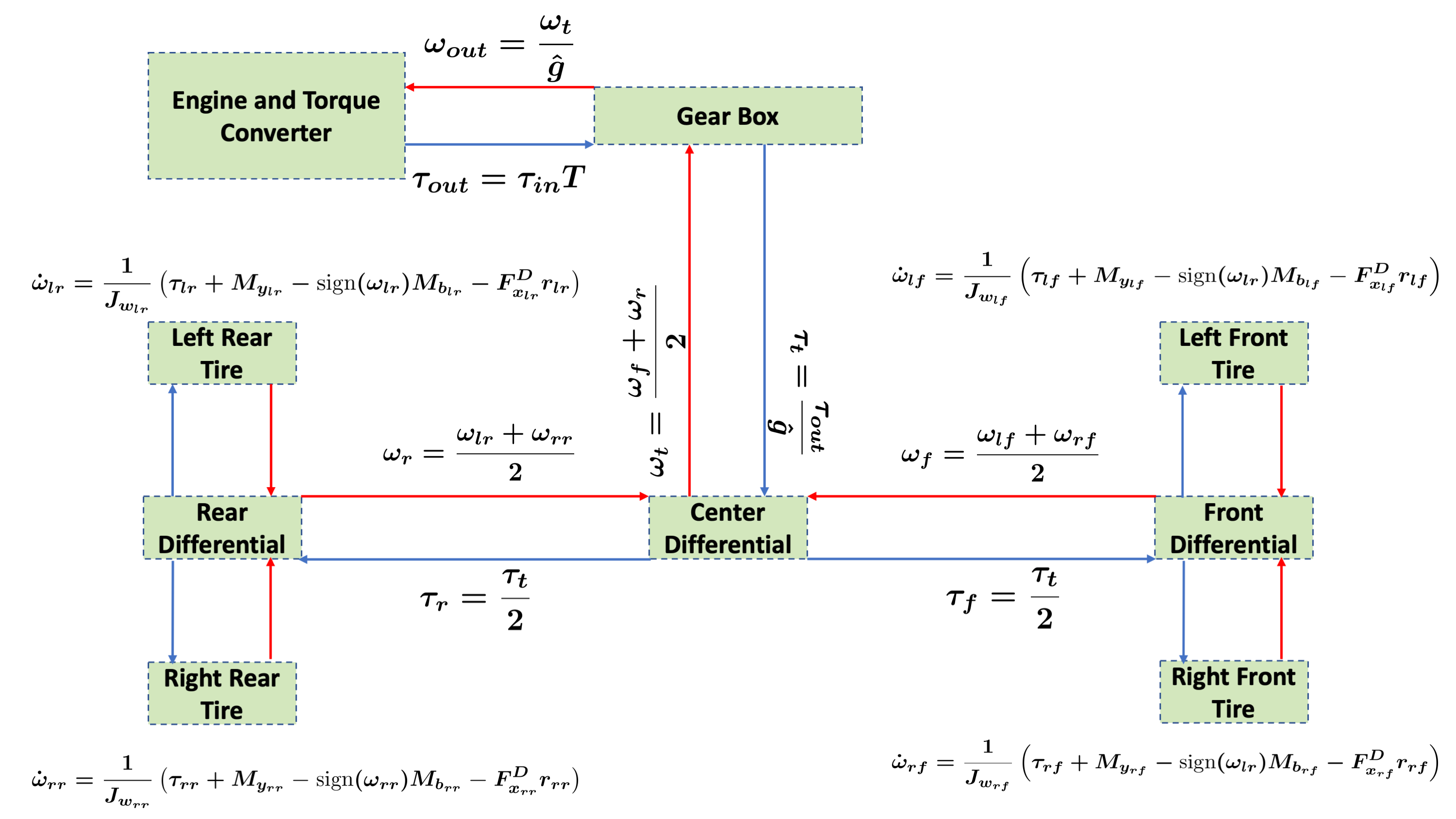 A Library of Lower Fidelity Dynamics Models (LFDMs) For On-Road Vehicle Dynamics Targeting Faster Than Real-Time ApplicationsJournal of Open Source Software, 2024Lower Fidelity Dynamic Models (LFDM) is a library of dynamics models for on-road wheeled vehicles that is written in C++ and CUDA and wrapped to Python using SWIG. Each model is described as a set of Ordinary Differential Equations (ODEs) that take a driver inputa normalized throttle between 0 and 1, a normalized steering between-1 and 1 (with-1 representing max steering toward a left turn), and a normalized braking input between 0 and 1, and subsequently advance the state of the vehicle (its position and velocity) forward in time.
A Library of Lower Fidelity Dynamics Models (LFDMs) For On-Road Vehicle Dynamics Targeting Faster Than Real-Time ApplicationsJournal of Open Source Software, 2024Lower Fidelity Dynamic Models (LFDM) is a library of dynamics models for on-road wheeled vehicles that is written in C++ and CUDA and wrapped to Python using SWIG. Each model is described as a set of Ordinary Differential Equations (ODEs) that take a driver inputa normalized throttle between 0 and 1, a normalized steering between-1 and 1 (with-1 representing max steering toward a left turn), and a normalized braking input between 0 and 1, and subsequently advance the state of the vehicle (its position and velocity) forward in time. -
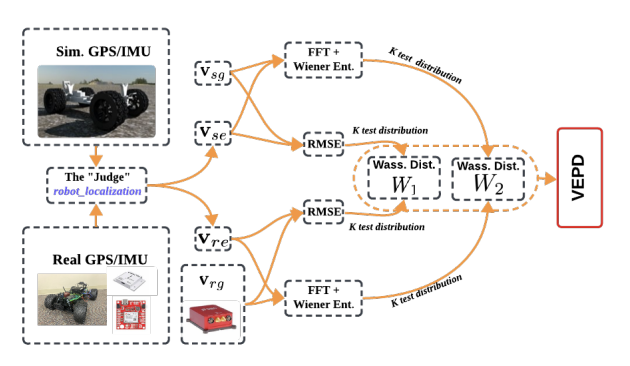 Quantifying the Sim2real Gap for GPS and IMU SensorsarXiv preprint arXiv:2403.11000, 2024Simulation can and should play a critical role in the development and testing of algorithms for autonomous agents. What might reduce its impact is the “sim2real” gap – the algorithm response differs between operation in simulated versus real-world environments. This paper introduces an approach to evaluate this gap, focusing on the accuracy of sensor simulation – specifically IMU and GPS – in velocity estimation tasks for autonomous agents. Using a scaled autonomous vehicle, we conduct 40 real-world experiments across diverse environments then replicate the experiments in simulation with five distinct sensor noise models. We note that direct comparison of raw simulation and real sensor data fails to quantify the sim2real gap for robotics applications. We demonstrate that by using a state of the art state-estimation package as a “judge”, and by evaluating the performance of this state-estimator in both real and simulated scenarios, we can isolate the sim2real discrepancies stemming from sensor simulations alone. The dataset generated is open-source and publicly available for unfettered use.
Quantifying the Sim2real Gap for GPS and IMU SensorsarXiv preprint arXiv:2403.11000, 2024Simulation can and should play a critical role in the development and testing of algorithms for autonomous agents. What might reduce its impact is the “sim2real” gap – the algorithm response differs between operation in simulated versus real-world environments. This paper introduces an approach to evaluate this gap, focusing on the accuracy of sensor simulation – specifically IMU and GPS – in velocity estimation tasks for autonomous agents. Using a scaled autonomous vehicle, we conduct 40 real-world experiments across diverse environments then replicate the experiments in simulation with five distinct sensor noise models. We note that direct comparison of raw simulation and real sensor data fails to quantify the sim2real gap for robotics applications. We demonstrate that by using a state of the art state-estimation package as a “judge”, and by evaluating the performance of this state-estimator in both real and simulated scenarios, we can isolate the sim2real discrepancies stemming from sensor simulations alone. The dataset generated is open-source and publicly available for unfettered use. -
 A Study on the Use of Simulation in Synthesizing Path-Following Control Policies for Autonomous Ground RobotsarXiv preprint arXiv:2403.18021, 2024We report results obtained and insights gained while answering the following question: how effective is it to use a simulator to establish path following control policies for an autonomous ground robot? While the quality of the simulator conditions the answer to this question, we found that for the simulation platform used herein, producing four control policies for path planning was straightforward once a digital twin of the controlled robot was available. The control policies established in simulation and subsequently demonstrated in the real world are PID control, MPC, and two neural network (NN) based controllers. Training the two NN controllers via imitation learning was accomplished expeditiously using seven simple maneuvers: follow three circles clockwise, follow the same circles counter-clockwise, and drive straight. A test randomization process that employs random micro-simulations is used to rank the “goodness” of the four control policies. The policy ranking noted in simulation correlates well with the ranking observed when the control policies were tested in the real world. The simulation platform used is publicly available and BSD3-released as open source; a public Docker image is available for reproducibility studies. It contains a dynamics engine, a sensor simulator, a ROS2 bridge, and a ROS2 autonomy stack the latter employed both in the simulator and the real world experiments.
A Study on the Use of Simulation in Synthesizing Path-Following Control Policies for Autonomous Ground RobotsarXiv preprint arXiv:2403.18021, 2024We report results obtained and insights gained while answering the following question: how effective is it to use a simulator to establish path following control policies for an autonomous ground robot? While the quality of the simulator conditions the answer to this question, we found that for the simulation platform used herein, producing four control policies for path planning was straightforward once a digital twin of the controlled robot was available. The control policies established in simulation and subsequently demonstrated in the real world are PID control, MPC, and two neural network (NN) based controllers. Training the two NN controllers via imitation learning was accomplished expeditiously using seven simple maneuvers: follow three circles clockwise, follow the same circles counter-clockwise, and drive straight. A test randomization process that employs random micro-simulations is used to rank the “goodness” of the four control policies. The policy ranking noted in simulation correlates well with the ranking observed when the control policies were tested in the real world. The simulation platform used is publicly available and BSD3-released as open source; a public Docker image is available for reproducibility studies. It contains a dynamics engine, a sensor simulator, a ROS2 bridge, and a ROS2 autonomy stack the latter employed both in the simulator and the real world experiments. -
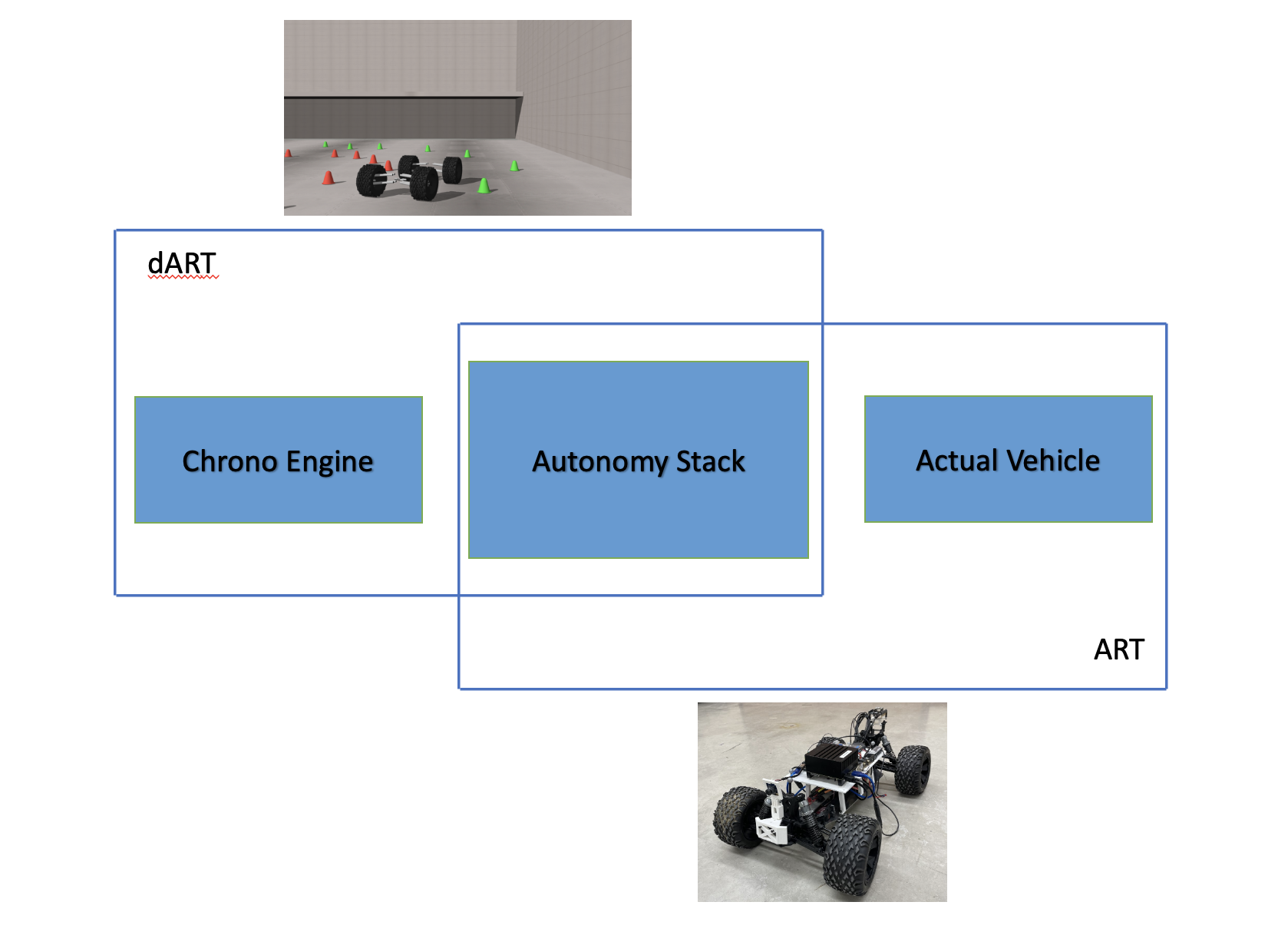 Using simulation to design an MPC policy for field navigation using GPS sensingECCOMAS Thematic Conference on Multibody Dynamics, 2023Modeling a robust control system with a precise GPS-based state estimation capability in simulation can be useful in field navigation applications as it allows for testing and validation in a controlled environment. This testing process would enable navigation systems to be developed and optimized in simulation with direct transferability to real-world scenarios. The multi-physics simulation engine Chrono allows for the creation of scenarios that may be difficult or dangerous to replicate in the field, such as extreme weather or terrain conditions. Autonomy Research Testbed (ART), a specialized robotics algorithm testbed, is operated in conjunction with Chrono to develop an MPC control policy as well as an EKF state estimator. This platform enables users to easily integrate custom algorithms in the autonomy stack. This model is initially developed and used in simulation and then tested on a twin vehicle model in reality, to demonstrate the transferability between simulation and reality (also known as Sim2Real).
Using simulation to design an MPC policy for field navigation using GPS sensingECCOMAS Thematic Conference on Multibody Dynamics, 2023Modeling a robust control system with a precise GPS-based state estimation capability in simulation can be useful in field navigation applications as it allows for testing and validation in a controlled environment. This testing process would enable navigation systems to be developed and optimized in simulation with direct transferability to real-world scenarios. The multi-physics simulation engine Chrono allows for the creation of scenarios that may be difficult or dangerous to replicate in the field, such as extreme weather or terrain conditions. Autonomy Research Testbed (ART), a specialized robotics algorithm testbed, is operated in conjunction with Chrono to develop an MPC control policy as well as an EKF state estimator. This platform enables users to easily integrate custom algorithms in the autonomy stack. This model is initially developed and used in simulation and then tested on a twin vehicle model in reality, to demonstrate the transferability between simulation and reality (also known as Sim2Real). -
 An Overview of a Framework for Designing Robot Autonomy Stacks in SimulationECCOMAS Thematic Conference on Multibody Dynamics, 2023We describe a software framework and a hardware platform used in tandem for the design and analysis of robot autonomy algorithms in simulation and reality. The software, which is open source, containerized, and operating system (OS) independent, has three main components: a ROS 2 interface to a vehicle simulation framework (Chrono), which provides high-fidelity wheeled/tracked vehicle and sensor simulation; a basic ROS 2-based autonomy stack for algorithm design and testing; and, a development ecosystem which enables visualization, and hardware-in-the-loop experimentation in perception, state estimation, path planning, and controls. The accompanying hardware platform is a 1/6th scale vehicle augmented with reconfigurable mountings for computing, sensing, and tracking. Its purpose is to allow algorithms and sensor configurations to be physically tested and improved. Since this vehicle platform has a digital twin within the simulation environment, one can test and compare the same algorithms and autonomy stack in simulation and reality. This platform has been built with an eye towards characterizing and managing the simulation-toreality gap. Herein, we describe how this platform is set up, deployed, and used to improve autonomy for mobility applications.
An Overview of a Framework for Designing Robot Autonomy Stacks in SimulationECCOMAS Thematic Conference on Multibody Dynamics, 2023We describe a software framework and a hardware platform used in tandem for the design and analysis of robot autonomy algorithms in simulation and reality. The software, which is open source, containerized, and operating system (OS) independent, has three main components: a ROS 2 interface to a vehicle simulation framework (Chrono), which provides high-fidelity wheeled/tracked vehicle and sensor simulation; a basic ROS 2-based autonomy stack for algorithm design and testing; and, a development ecosystem which enables visualization, and hardware-in-the-loop experimentation in perception, state estimation, path planning, and controls. The accompanying hardware platform is a 1/6th scale vehicle augmented with reconfigurable mountings for computing, sensing, and tracking. Its purpose is to allow algorithms and sensor configurations to be physically tested and improved. Since this vehicle platform has a digital twin within the simulation environment, one can test and compare the same algorithms and autonomy stack in simulation and reality. This platform has been built with an eye towards characterizing and managing the simulation-toreality gap. Herein, we describe how this platform is set up, deployed, and used to improve autonomy for mobility applications. -
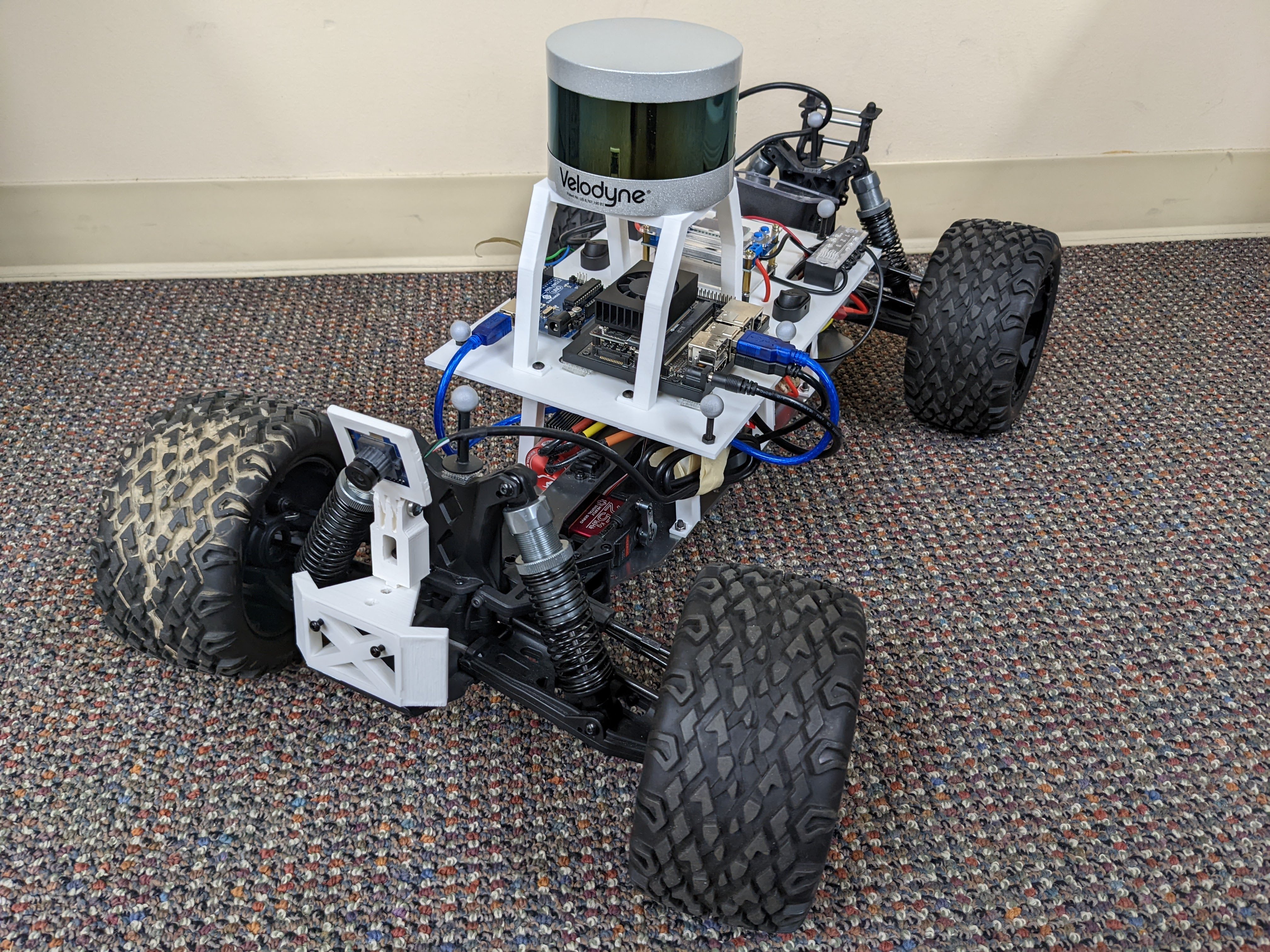 A software toolkit and hardware platform for investigating and comparing robot autonomy algorithms in simulation and realityMiniRobots Workshop at IEEE/RSJ International Conference on Intelligent Robots and Systems (IROS), 2022We describe a software framework and a hardware platform used in tandem for the design and analysis of robot autonomy algorithms in simulation and reality. The software, which is open source, containerized, and operating system (OS) independent, has three main components: a ROS 2 interface to a C++ vehicle simulation framework (Chrono), which provides high-fidelity wheeled/tracked vehicle and sensor simulation; a basic ROS 2-based autonomy stack for algorithm design and testing; and, a development ecosystem which enables visualization, and hardware-in-the-loop experimentation in perception, state estimation, path planning, and controls. The accompanying hardware platform is a 1/6th scale vehicle augmented with reconfigurable mountings for computing, sensing, and tracking. Its purpose is to allow algorithms and sensor configurations to be physically tested and improved. Since this vehicle platform has a digital twin within the simulation environment, one can test and compare the same algorithms and autonomy stack in simulation and reality. This platform has been built with an eye towards characterizing and managing the simulation-to-reality gap. Herein, we describe how this platform is set up, deployed, and used to improve autonomy for mobility applications.
A software toolkit and hardware platform for investigating and comparing robot autonomy algorithms in simulation and realityMiniRobots Workshop at IEEE/RSJ International Conference on Intelligent Robots and Systems (IROS), 2022We describe a software framework and a hardware platform used in tandem for the design and analysis of robot autonomy algorithms in simulation and reality. The software, which is open source, containerized, and operating system (OS) independent, has three main components: a ROS 2 interface to a C++ vehicle simulation framework (Chrono), which provides high-fidelity wheeled/tracked vehicle and sensor simulation; a basic ROS 2-based autonomy stack for algorithm design and testing; and, a development ecosystem which enables visualization, and hardware-in-the-loop experimentation in perception, state estimation, path planning, and controls. The accompanying hardware platform is a 1/6th scale vehicle augmented with reconfigurable mountings for computing, sensing, and tracking. Its purpose is to allow algorithms and sensor configurations to be physically tested and improved. Since this vehicle platform has a digital twin within the simulation environment, one can test and compare the same algorithms and autonomy stack in simulation and reality. This platform has been built with an eye towards characterizing and managing the simulation-to-reality gap. Herein, we describe how this platform is set up, deployed, and used to improve autonomy for mobility applications.